Index to Flowers in the Order Fabales
Family: Fabaceae
Abrus precatorius africanus Lucky Bean Creeper viewtopic.php?p=526837#p526837
Chamaecrista absus Tropical Sensitive Pea viewtopic.php?f=248&t=3729#p170698
Crotalaria laburnifolia australis Brown-and-yellow Rattle-pod viewtopic.php?p=204724#p204724
Lessertia frutescens, Sutherlandia frutescens Cancer Bush, Balloon Pea viewtopic.php?p=201385#p201385
Indigofera sanguinea Bright Indigo viewtopic.php?p=534727#p534727
Indigofera spicata Creeping Indigo viewtopic.php?f=248&t=3729&p=170477#p170700
Senna italica arachoides Eland's Pea, Wild Senna viewtopic.php?f=248&t=3729&p=170477#p170701
Tephrosia purpurea leptostachya Wild Indigo viewtopic.php?f=248&t=3729&p=170477#p170703
Zornia capensis capensis Cape Caterpillarbean viewtopic.php?p=532451#p532451
Family: Polygalaceae (Milkwort family)
Polygala fruticosa Featherdusters, Heart-leaved Polygala viewtopic.php?f=248&t=3729&p=175389#p175389
Polygala myrtifolia September Bush viewtopic.php?p=241873#p241873
Africa Wild Flower Book - Order Fabales
Moderator: Klipspringer
Re: Africa Wild Flower Book - Order Fabales
Tropical Sensitive Pea Chamaecrista absus
Order: Fabales. Family: Fabaceae. Subfamily: Caesalpinioideae
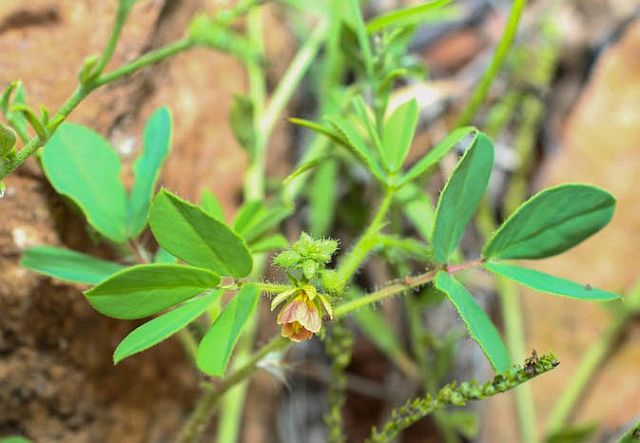 © Super Mongoose
© Super Mongoose
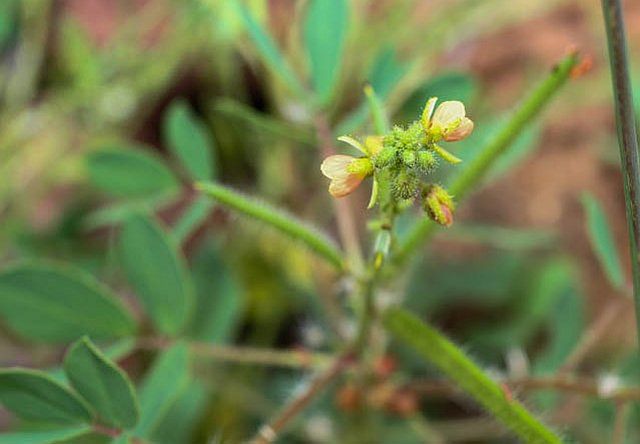 © Super Mongoose
© Super Mongoose
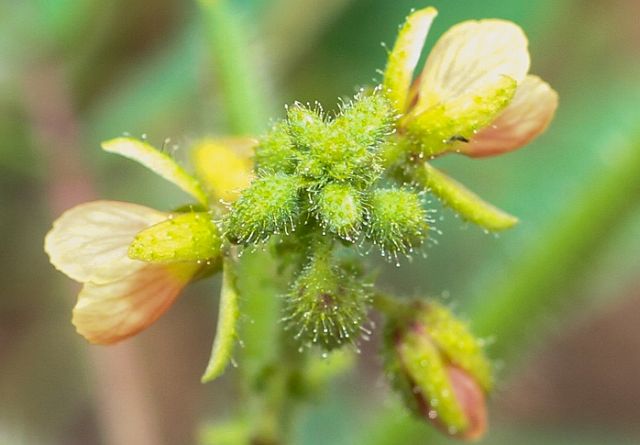 © Super Mongoose
© Super Mongoose
Vaalkop Dam Nature Reserve, North West Province
Description
Annual herb, to 60 cm, glandular-hairy. Leaves: petiole to 4 cm, without a gland; leaves with 2 pairs of opposite leaflets with a gland on the rhachis between each pair. Inflorescences terminal. Petals 5-6 mm, yellow, orange, salmon or pinkish-red with reddish-brown veins. Stamens 5, subequal; filaments straight. Pod 3-6 cm, flat.
Distribution
Chamaecrista absus has a very large geographical distribution, that includes North and South America, tropical Africa, southern
Asia and Australasia. Provincial distribution in South Africa: Gauteng, Limpopo, Mpumalanga, North West.
Habitat
In disturbed grassland or open woodland, also on roadsides, riverine alluvium and former cultivated areas.
Order: Fabales. Family: Fabaceae. Subfamily: Caesalpinioideae
 © Super Mongoose
© Super Mongoose © Super Mongoose
© Super Mongoose © Super Mongoose
© Super MongooseVaalkop Dam Nature Reserve, North West Province
Description
Annual herb, to 60 cm, glandular-hairy. Leaves: petiole to 4 cm, without a gland; leaves with 2 pairs of opposite leaflets with a gland on the rhachis between each pair. Inflorescences terminal. Petals 5-6 mm, yellow, orange, salmon or pinkish-red with reddish-brown veins. Stamens 5, subequal; filaments straight. Pod 3-6 cm, flat.
Distribution
Chamaecrista absus has a very large geographical distribution, that includes North and South America, tropical Africa, southern
Asia and Australasia. Provincial distribution in South Africa: Gauteng, Limpopo, Mpumalanga, North West.
Habitat
In disturbed grassland or open woodland, also on roadsides, riverine alluvium and former cultivated areas.
- Flutterby
- Posts: 44150
- Joined: Sat May 19, 2012 12:28 pm
- Country: South Africa
- Location: Gauteng, South Africa
- Contact:
Re: Africa Wild Flower Book - Order Fabales
Creeping Indigo Indigofera spicata
Order: Fabales. Family: Fabaceae
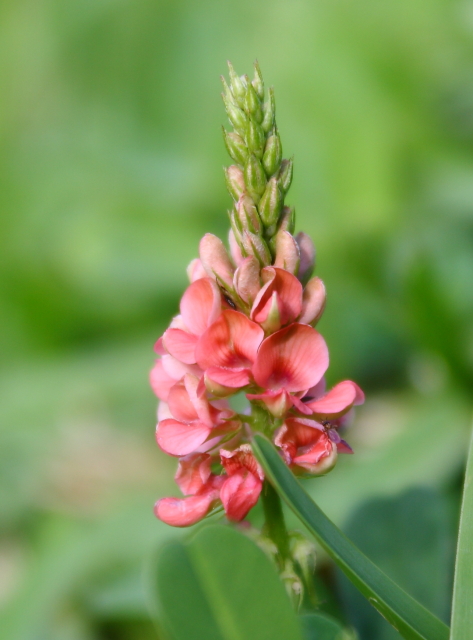
Description
Perennial herb with prostrate or semi erect creeping stems growing from a woody rootstock. The leaflets on the compound leaves are arranged alternately. The inflorescences arranged in erect, spike-like racemes, salmon pink to red.
Habitat
Sandy grassland, often in rocky places. Coastal and montane grasslands, coastal dunes and disturbed places.
Distribution
Eastern Cape, Gauteng, KwaZulu-Natal, Limpopo, Mpumalanga, North West. Extremely widespread across tropical Africa and Madagascar to the northern provinces of South Africa and southwards through KwaZulu-Natal to the eastern parts of the Eastern Cape.
Order: Fabales. Family: Fabaceae

Description
Perennial herb with prostrate or semi erect creeping stems growing from a woody rootstock. The leaflets on the compound leaves are arranged alternately. The inflorescences arranged in erect, spike-like racemes, salmon pink to red.
Habitat
Sandy grassland, often in rocky places. Coastal and montane grasslands, coastal dunes and disturbed places.
Distribution
Eastern Cape, Gauteng, KwaZulu-Natal, Limpopo, Mpumalanga, North West. Extremely widespread across tropical Africa and Madagascar to the northern provinces of South Africa and southwards through KwaZulu-Natal to the eastern parts of the Eastern Cape.
Re: Africa Wild Flower Book - Order Fabales
Eland's Pea, Wild Senna Senna italica arachoides (Swartstorm, Wilde Ertjies)
Order: Fabales. Family: Fabaceae. Subfamily: Caesalpinioideae
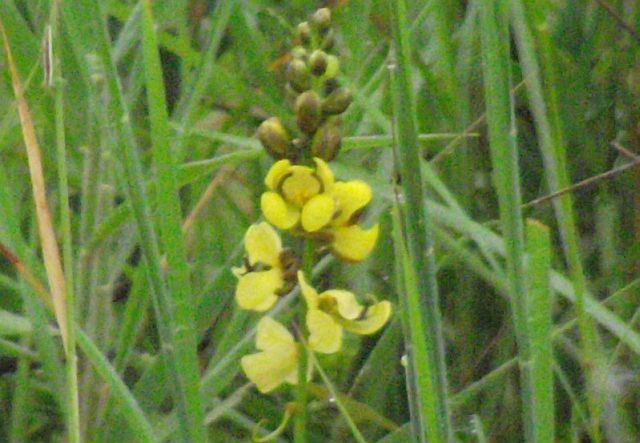 © mpostumus
© mpostumus
Kruger National Park, around Pretoriuskop
Description
Prostrate or ascending perennial herb or small shrub, up to 60 cm high, growing from a woody base. Leaves paripinnate with 4-8 pairs of leaflets and a small reddish gland between each leaflet pair on the rhachis; leaflets obovate with a somewhat asymmetric base, up to 3.5 × 2 cm, the ultimate pair largest, slightly pubescent or hairless above, more densely hairy on the margin and midrib below; apex often mucronate. Inflorescences axillary, many-flowered, 7-26 cm long. Flowers yellow to orange. Pod often somewhat curved, flat with distinct raised crests over the seeds, dehiscent.
Distribution
Botswana, Namibia, Mozambique, Zimbabwe, Swaziland and South Africa (Free State, Gauteng, KwaZulu-Natal, Limpopo, Mpumalanga, Northern Cape, North West).
Habitat
In rocky and gravelly soils in dry open woodland.
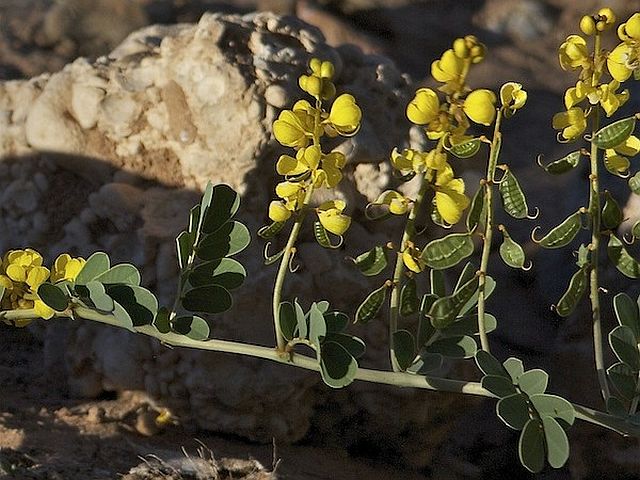 © ExFmem
© ExFmem
Kgalagadi Transfrontier Park
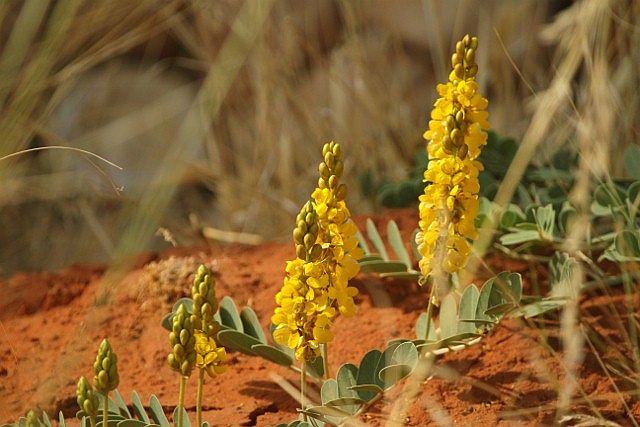 © nan
© nan
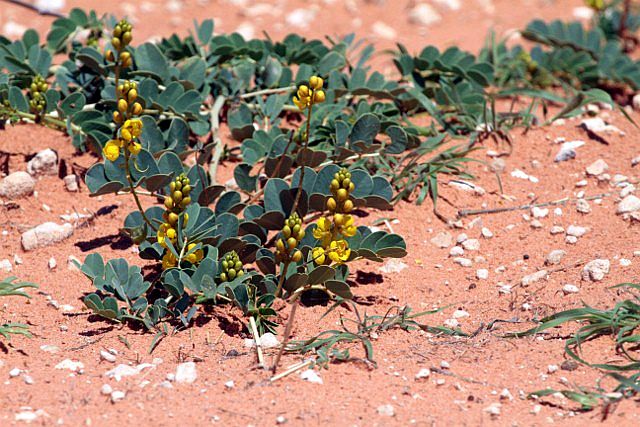 © nan
© nan
Kgalagadi Transfrontier Park
Order: Fabales. Family: Fabaceae. Subfamily: Caesalpinioideae
 © mpostumus
© mpostumusKruger National Park, around Pretoriuskop
Description
Prostrate or ascending perennial herb or small shrub, up to 60 cm high, growing from a woody base. Leaves paripinnate with 4-8 pairs of leaflets and a small reddish gland between each leaflet pair on the rhachis; leaflets obovate with a somewhat asymmetric base, up to 3.5 × 2 cm, the ultimate pair largest, slightly pubescent or hairless above, more densely hairy on the margin and midrib below; apex often mucronate. Inflorescences axillary, many-flowered, 7-26 cm long. Flowers yellow to orange. Pod often somewhat curved, flat with distinct raised crests over the seeds, dehiscent.
Distribution
Botswana, Namibia, Mozambique, Zimbabwe, Swaziland and South Africa (Free State, Gauteng, KwaZulu-Natal, Limpopo, Mpumalanga, Northern Cape, North West).
Habitat
In rocky and gravelly soils in dry open woodland.
 © ExFmem
© ExFmemKgalagadi Transfrontier Park
 © nan
© nan © nan
© nanKgalagadi Transfrontier Park
Re: Africa Wild Flower Book - Order Fabales
Wild Indigo Tephrosia purpurea leptostachya
Order: Fabales. Family: Fabaceae
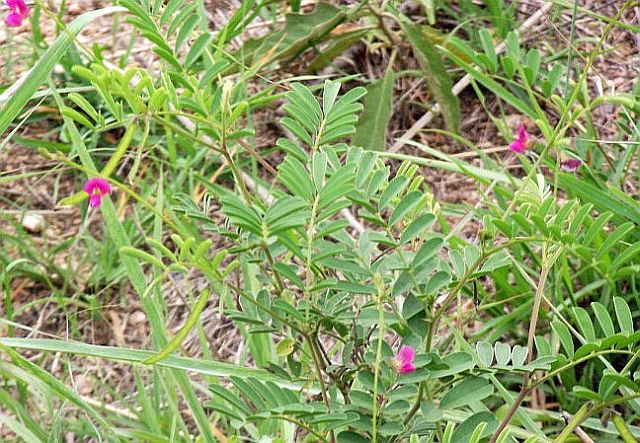 © mpostumus
© mpostumus
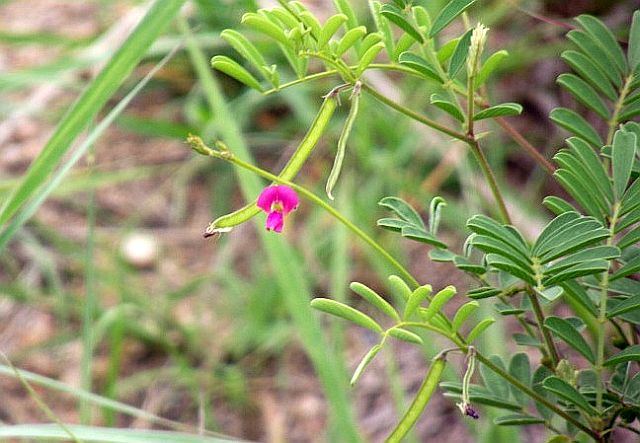 © mpostumus
© mpostumus
Kruger National Park, Biyamiti
Description
Herb with procumbent ascending stems. Magenta-pink flowers. Leaflets glabrous above; hairs on stems, leaf-rhachis and pods appressed, sometimes almost absent. Most characteristic is the shape of its pod: convex around the seeds with a distinctive flat area in between.
Distribution
Senegal to Nigeria, Burundi, Sudan, Ethiopia, Somalia, Mozambique, Malawi, Zimbabwe, Angola, South Africa (Provincial distribution: Gauteng, KwaZulu-Natal, Limpopo, Mpumalanga, Northern Cape, North West).
Habitat
Bushveld and grassland.
Order: Fabales. Family: Fabaceae
 © mpostumus
© mpostumus © mpostumus
© mpostumusKruger National Park, Biyamiti
Description
Herb with procumbent ascending stems. Magenta-pink flowers. Leaflets glabrous above; hairs on stems, leaf-rhachis and pods appressed, sometimes almost absent. Most characteristic is the shape of its pod: convex around the seeds with a distinctive flat area in between.
Distribution
Senegal to Nigeria, Burundi, Sudan, Ethiopia, Somalia, Mozambique, Malawi, Zimbabwe, Angola, South Africa (Provincial distribution: Gauteng, KwaZulu-Natal, Limpopo, Mpumalanga, Northern Cape, North West).
Habitat
Bushveld and grassland.
-
Duke
Re: Africa Wild Flower Book - Order Fabales
Featherdusters, Heart-leaved Polygala Polygala fruticosa
Order: Fabales. Family: Polygalaceae
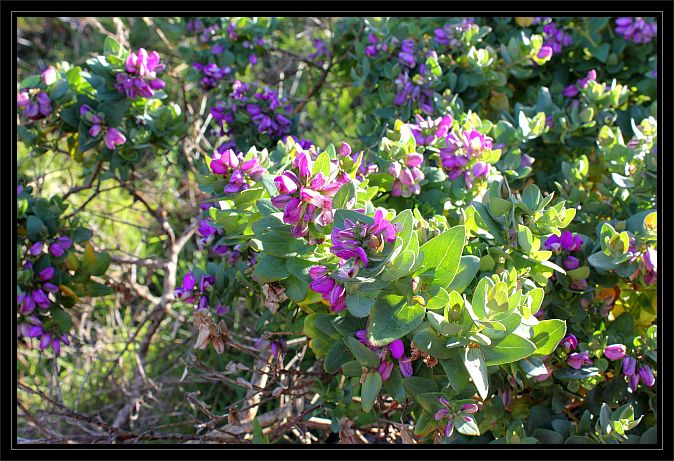
Tsitsikamma
Description
Shrub to 2 m, with opposite, ± heart-shaped leaves, and short racemes of pale greenish or purple flowers, 10-15 mm long, with deeply 2-lobed lateral petals.
The young leaves of this indigenous evergreen are tinged with purple, the shade echoed by the deep purple, winged flowers. Peak displays of flowers occur from spring to early summer. It also produces a scattering of blooms throughout the year. Bees are particularly attracted to the nectar that the flowers produce and are the main pollinators. Seeds are enclosed in papery, flattened capsules that remain on the bush for quite some time during and after flowering.
The flowers superficially resemble those of the pea and legume family but are actually quite different. All members of this genus have three to five sepals and three to five petals. The two lateral sepals are petal-like, larger than the others, coloured like the petals, and resemble the wing petals of a pea flower. The lower petal is boat-shaped and encloses the eight stamens and the style, and resembles the keel of a pea flower. A characteristic of all polygalas that makes them easily distinguishable from the pea is the brush-like tuft on the lower, keel-like petal. Closer inspection also reveals that the flowers do not have a large standard petal (also called the banner) like pea flowers do. Another distinguishing difference is that polygalas do not bear leguminous fruit.
Distribution
Polygala fruticosa is a native of South Africa, growing on mountain slopes and coastal hills from the southern Cape to the Karoo and KwaZulu-Natal.
Habitat
Rocky sandstone and clay slopes.
Links: PlantZAfrica; John Manning:Field Guide to Fynbos
Order: Fabales. Family: Polygalaceae

Tsitsikamma
Description
Shrub to 2 m, with opposite, ± heart-shaped leaves, and short racemes of pale greenish or purple flowers, 10-15 mm long, with deeply 2-lobed lateral petals.
The young leaves of this indigenous evergreen are tinged with purple, the shade echoed by the deep purple, winged flowers. Peak displays of flowers occur from spring to early summer. It also produces a scattering of blooms throughout the year. Bees are particularly attracted to the nectar that the flowers produce and are the main pollinators. Seeds are enclosed in papery, flattened capsules that remain on the bush for quite some time during and after flowering.
The flowers superficially resemble those of the pea and legume family but are actually quite different. All members of this genus have three to five sepals and three to five petals. The two lateral sepals are petal-like, larger than the others, coloured like the petals, and resemble the wing petals of a pea flower. The lower petal is boat-shaped and encloses the eight stamens and the style, and resembles the keel of a pea flower. A characteristic of all polygalas that makes them easily distinguishable from the pea is the brush-like tuft on the lower, keel-like petal. Closer inspection also reveals that the flowers do not have a large standard petal (also called the banner) like pea flowers do. Another distinguishing difference is that polygalas do not bear leguminous fruit.
Distribution
Polygala fruticosa is a native of South Africa, growing on mountain slopes and coastal hills from the southern Cape to the Karoo and KwaZulu-Natal.
Habitat
Rocky sandstone and clay slopes.
Links: PlantZAfrica; John Manning:Field Guide to Fynbos
Re: Africa Wild Flower Book - Order Fabales
Cancer Bush, Balloon Pea Lessertia frutescens previously Sutherlandia frutescens (Kankerbos)
Order: Fabales. Family: Fabaceae. Subfamily: Faboideae
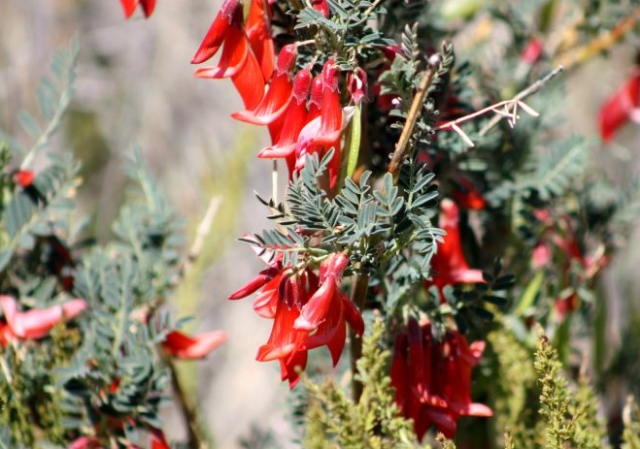 © Tataruka
© Tataruka
Western Cape, Central Karoo, Beaufort West
Description
Small, soft wooded shrublet, 0.5 to 1 m in height. The leaves are pinnately compound. The leaflets are 4-10 mm long, grey-green in colour, giving the bush a silvery appearance. They have a very bitter taste.
The flowers are orange-red, up to 35 mm long, and are carried in short racemes in the leaf axils at the tips of the branches in spring to mid-summer (September - December). The flowers are not typical 'pea' flowers, the wing petals are very small and are concealed in the calyx, and the standard petal is much shorter than the keel.
The large inflated pods appear papery when ripe. Pods are membranous, showing a pink, beige or greenish translucence. A ripe pod breaking off from the plant may be blown away by the wind, depositing its seeds in a new spot where no particular soil type is required for them to grow, once there is moisture. The small black seeds are flattish, about 3 mm in diameter. They have rough surfaces.
Distribution
It occurs naturally throughout the dry parts of southern Africa, in Western Cape and up the west coast as far north as Namibia and into Botswana, and in the western Karoo to Eastern Cape.
Habitat
Widespread in drier areas of the South Western and Northern Cape Provinces; on sandstone and shale flats and slopes; often as a weed of disturbed places e.g. road verges.
Links: John Manning: Field Guide to Fynbos
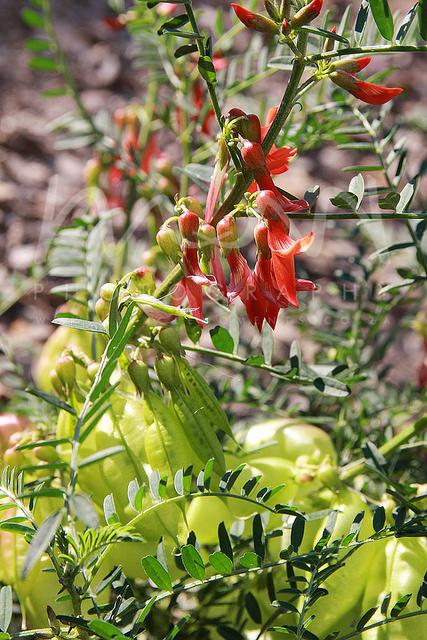 © Michael de Nysschen
© Michael de Nysschen
Order: Fabales. Family: Fabaceae. Subfamily: Faboideae
 © Tataruka
© TatarukaWestern Cape, Central Karoo, Beaufort West
Description
Small, soft wooded shrublet, 0.5 to 1 m in height. The leaves are pinnately compound. The leaflets are 4-10 mm long, grey-green in colour, giving the bush a silvery appearance. They have a very bitter taste.
The flowers are orange-red, up to 35 mm long, and are carried in short racemes in the leaf axils at the tips of the branches in spring to mid-summer (September - December). The flowers are not typical 'pea' flowers, the wing petals are very small and are concealed in the calyx, and the standard petal is much shorter than the keel.
The large inflated pods appear papery when ripe. Pods are membranous, showing a pink, beige or greenish translucence. A ripe pod breaking off from the plant may be blown away by the wind, depositing its seeds in a new spot where no particular soil type is required for them to grow, once there is moisture. The small black seeds are flattish, about 3 mm in diameter. They have rough surfaces.
Distribution
It occurs naturally throughout the dry parts of southern Africa, in Western Cape and up the west coast as far north as Namibia and into Botswana, and in the western Karoo to Eastern Cape.
Habitat
Widespread in drier areas of the South Western and Northern Cape Provinces; on sandstone and shale flats and slopes; often as a weed of disturbed places e.g. road verges.
Links: John Manning: Field Guide to Fynbos
 © Michael de Nysschen
© Michael de NysschenRe: Africa Wild Flower Book - Order Fabales
Brown-and-yellow Rattle-pod, Rattlepod Crotalaria laburnifolia australis
Order: Fabales. Family: Fabaceae. Subfamily: Faboideae
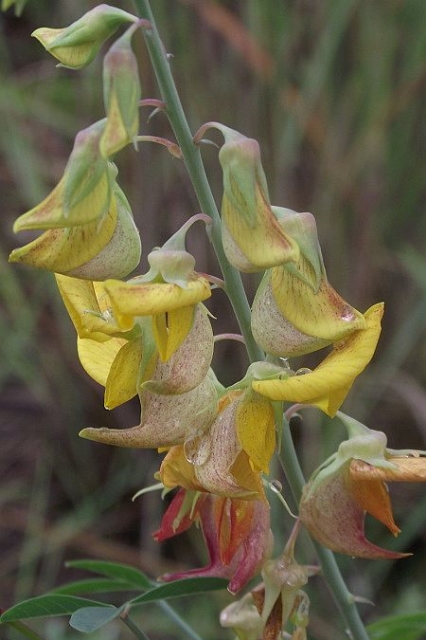 © mposthumus
© mposthumus
Kruger National Park, Pretoriuskop area
Description
Erect, herbaceous shrub, becoming somewhat woody, hairiess throughout. Leaf-stalks up to 8 cm long, exceeding leaflets, which are broadly oval, blunt-tipped, up to 3 cm long x 2 cm wide. Flowers are produced in a 150-400 mm long inflorescence; inflorescence erect, tenninal, many-flowered raceme. Flowers yellow, pea-like; standard erect or reflexed, often marked red-brown, keel rounded with an upwardly pointing tip (20-30 mm long) (Jan-May); stalk very slender. Fruits cylindrical, c 6 cm long x 1 cm diam, on stalk c 2,5 cm long.
This subsp. is distinguished by the leaves being hairless, never obovate, rounded at the apex and sometimes emarginate. The pods are longer, up to 10.5 cm, with the base tapering into the stipe, which is less than half as long as the pod.
Distribution
Botswana, Namibia, Mozambique, Zimbabwe, Swaziland and South Africa (Gauteng, KwaZulu-Natal, Limpopo, Mpumalanga, North West).
Habitat
In tree savanna, bushveld and grassland, often along roadsides and in disturbed places.
Links: Trees and Shrubs of Mpumalanga and Kruger National Park
Order: Fabales. Family: Fabaceae. Subfamily: Faboideae
 © mposthumus
© mposthumusKruger National Park, Pretoriuskop area
Description
Erect, herbaceous shrub, becoming somewhat woody, hairiess throughout. Leaf-stalks up to 8 cm long, exceeding leaflets, which are broadly oval, blunt-tipped, up to 3 cm long x 2 cm wide. Flowers are produced in a 150-400 mm long inflorescence; inflorescence erect, tenninal, many-flowered raceme. Flowers yellow, pea-like; standard erect or reflexed, often marked red-brown, keel rounded with an upwardly pointing tip (20-30 mm long) (Jan-May); stalk very slender. Fruits cylindrical, c 6 cm long x 1 cm diam, on stalk c 2,5 cm long.
This subsp. is distinguished by the leaves being hairless, never obovate, rounded at the apex and sometimes emarginate. The pods are longer, up to 10.5 cm, with the base tapering into the stipe, which is less than half as long as the pod.
Distribution
Botswana, Namibia, Mozambique, Zimbabwe, Swaziland and South Africa (Gauteng, KwaZulu-Natal, Limpopo, Mpumalanga, North West).
Habitat
In tree savanna, bushveld and grassland, often along roadsides and in disturbed places.
Links: Trees and Shrubs of Mpumalanga and Kruger National Park
Re: Africa Wild Flower Book - Order Fabales
September Bush Polygala myrtifolia (Septemberbos, Bloukappie)
Order: Fabales. Family: Polygalaceae
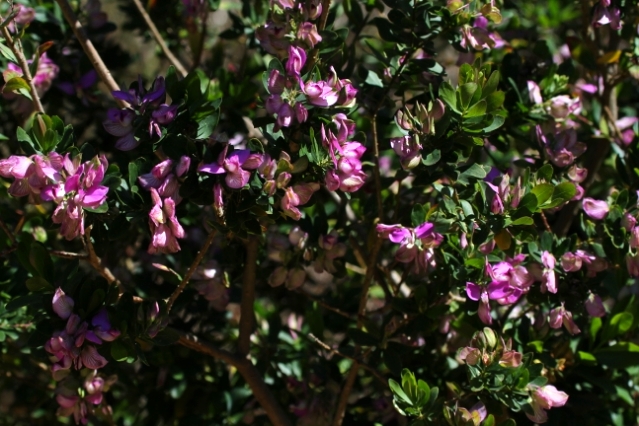 © Tina
© Tina
Kirstenbosch
Description
Sprawling or erect shrub to 2 m, often velvety on the young stems, the leaves either ascending and narrow with the margins slightly rolled under, or broadly elliptical and flat; bears large showy, pink, pale-mauve, or reddish-purple flowers 12 mm long, which are often conspicuously veined. Flowers in short terminal racemes; the side petals are bilobed with the lower lobe much longer than the upper. Polygala myrtifolia has blooms throughout the year with a peak in spring (August to October) when the plants flower profusely. The fruit is a small, winged capsule.
Distribution
Provincial distribution in South Africa: Eastern Cape, Gauteng, KwaZulu-Natal, Northern Cape, Western Cape. Polygala myrtifolia occurs naturally from the Bokkeveld Mountains near Clanwilliam in the Western Cape to Kwazulu-Natal.
Habitat
Rocky slopes, dunes, forests, along streams, in scrub and open grassland.
Links: PlantZAfrica; John Manning: Field Guide to Fynbos
Order: Fabales. Family: Polygalaceae
 © Tina
© TinaKirstenbosch
Description
Sprawling or erect shrub to 2 m, often velvety on the young stems, the leaves either ascending and narrow with the margins slightly rolled under, or broadly elliptical and flat; bears large showy, pink, pale-mauve, or reddish-purple flowers 12 mm long, which are often conspicuously veined. Flowers in short terminal racemes; the side petals are bilobed with the lower lobe much longer than the upper. Polygala myrtifolia has blooms throughout the year with a peak in spring (August to October) when the plants flower profusely. The fruit is a small, winged capsule.
Distribution
Provincial distribution in South Africa: Eastern Cape, Gauteng, KwaZulu-Natal, Northern Cape, Western Cape. Polygala myrtifolia occurs naturally from the Bokkeveld Mountains near Clanwilliam in the Western Cape to Kwazulu-Natal.
Habitat
Rocky slopes, dunes, forests, along streams, in scrub and open grassland.
Links: PlantZAfrica; John Manning: Field Guide to Fynbos
-
Klipspringer
- Global Moderator
- Posts: 5862
- Joined: Sat Sep 14, 2013 12:34 pm
- Country: Germany
- Contact:
Re: Africa Wild Flower Book - Order Fabales
Lucky Bean Creeper Abrus precatorius africanus
Order Fabales. Family Fabaceae. Subfamily Faboideae
Nelspruit, November 2020 © Richprins
Description
A slender, perennial woody climber that twines around trees, shrubs, and hedges. It has no special organs of attachment. It has slender branches and a cylindrical wrinkled stem with a smooth-textured brown bark.
Leaves are glabrous with long internodes and are alternate compound paripinnate with stipules. Each leaf is 50-100 mm long. It bears from 20 to 24 or more leaflets, each of which is about 12-18 mm long, oblong and obtuse. It is blunt at both ends, glabrous on top and slightly hairy below.
Flowering time: November–March. Flowers are small and pale violet with a short stalk, arranged in clusters. The ovary has a marginal placentation.
The fruit, which is a pod, is flat, oblong and truncate-shaped with a sharp, deflexed beak, 30-45 x 12 mm, and silky-textured. The pod curls back when opened to reveal pendulous seeds, and contains from 3 to 5 oval-shaped seeds, about 6 mm long. The seeds
are spherical, smooth, of a bright, shining red or white colour, with a black mark at the eye.
Distribution
Widespread in Africa and Asia, Madagascar, Seychelles and Mauritius. Introduced into the Americas, West Indies and Hawaii.
Common in KwaZulu-Natal and Limpopo. Provincial distribution in South Africa: Eastern Cape, KwaZulu-Natal, Limpopo, Mpumalanga.
Habitat
It is a common weed of roadsides, old gardens, disturbed sites, waste areas and waterways (i.e. riparian areas) in the higher rainfall regions of subtropical areas. It has also been reported from open woodlands, rainforest margins and coastal dunes.
The seeds are highly poisonous and are often encountered in cases of criminal poisoning
Links:
https://www.researchgate.net/publicatio ... 0/download
http://pza.sanbi.org/abrus-precatorius-subsp-africanus
Order Fabales. Family Fabaceae. Subfamily Faboideae
Nelspruit, November 2020 © Richprins
Description
A slender, perennial woody climber that twines around trees, shrubs, and hedges. It has no special organs of attachment. It has slender branches and a cylindrical wrinkled stem with a smooth-textured brown bark.
Leaves are glabrous with long internodes and are alternate compound paripinnate with stipules. Each leaf is 50-100 mm long. It bears from 20 to 24 or more leaflets, each of which is about 12-18 mm long, oblong and obtuse. It is blunt at both ends, glabrous on top and slightly hairy below.
Flowering time: November–March. Flowers are small and pale violet with a short stalk, arranged in clusters. The ovary has a marginal placentation.
The fruit, which is a pod, is flat, oblong and truncate-shaped with a sharp, deflexed beak, 30-45 x 12 mm, and silky-textured. The pod curls back when opened to reveal pendulous seeds, and contains from 3 to 5 oval-shaped seeds, about 6 mm long. The seeds
are spherical, smooth, of a bright, shining red or white colour, with a black mark at the eye.
Distribution
Widespread in Africa and Asia, Madagascar, Seychelles and Mauritius. Introduced into the Americas, West Indies and Hawaii.
Common in KwaZulu-Natal and Limpopo. Provincial distribution in South Africa: Eastern Cape, KwaZulu-Natal, Limpopo, Mpumalanga.
Habitat
It is a common weed of roadsides, old gardens, disturbed sites, waste areas and waterways (i.e. riparian areas) in the higher rainfall regions of subtropical areas. It has also been reported from open woodlands, rainforest margins and coastal dunes.
The seeds are highly poisonous and are often encountered in cases of criminal poisoning
Links:
https://www.researchgate.net/publicatio ... 0/download
http://pza.sanbi.org/abrus-precatorius-subsp-africanus


